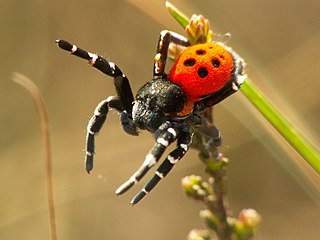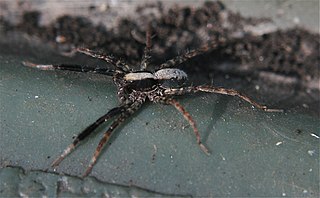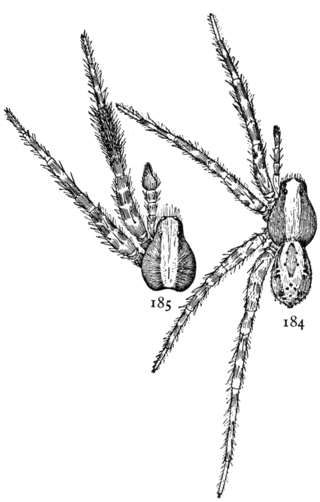
Wolf spiders are members of the family Lycosidae, so named for their robust and agile hunting skills and excellent eyesight. They live mostly in solitude, hunt alone, and usually do not spin webs. Some are opportunistic hunters, pouncing upon prey as they find it or chasing it over short distances; others wait for passing prey in or near the mouth of a burrow.

Sexual selection in spiders shows how sexual selection explains the evolution of phenotypic traits in spiders. Male spiders have many complex courtship rituals and have to avoid being eaten by the females, with the males of most species surviving only a few matings and consequently having short life-spans.

Schizocosa is a genus of wolf spiders containing around 60 species, distributed in North and South America, Africa, and East and Southeast Asia.
Schizocosa saltatrix is a species of wolf spider in the family Lycosidae. It is found in North America.
Zonitis bilineata is a species of blister beetle in the family Meloidae. It is found in North America.
Philaenarcys bilineata, the prairie spittlebug, is a species of spittlebug in the family Aphrophoridae. It is found in North America. Habitats it can be found in include prairies and boreal forests.
Metria bilineata is a species of moth in the family Erebidae.

Atalantycha bilineata, known generally as the two-lined cantharid or two-lined leather-wing, is a species of soldier beetle in the family Cantharidae. It is found in North America.
Schizocosa retrorsa is a species of wolf spider in the family Lycosidae. It is found in the United States and Mexico.
Ophraella bilineata is a species of skeletonizing leaf beetle in the family Chrysomelidae. It is found in North America.

Cesonia bilineata, the two-lined stealthy ground spider, is a species of ground spider in the family Gnaphosidae. It is found in North America. It is found in a variety of habitats: forests, prairies and even urban areas. In summer females lay their eggs in a sac under stones or leaves.

Schizocosa crassipes is a species of wolf spider in the family Lycosidae. It is found in the United States.

Tapinopa bilineata is a species of sheetweb spider in the family Linyphiidae. It is found in the United States.

Cordulegaster bilineata, the brown spiketail, is a species of spiketail in the dragonfly family Cordulegastridae. It is found in North America.

Schizocosa avida is a species of wolf spider in the family Lycosidae. It is found in North America.
Schizocosa minnesotensis is a species of wolf spider in the family Lycosidae. It is found in the United States and Canada.

Schizocosa ocreata is a species of wolf spider in the family Lycosidae that is found in North America. The Schizocosa ocreata is a spider that is most commonly known as the “brush-legged wolf spider” because of their distinct dark-colored fur-like coverings around their legs. The S. ocreata are commonly found in North American states, usually in the middle and eastern United States.

Schizocosa mccooki is a species of wolf spider in the family Lycosidae. They can be found from the west coast to western Lake Erie in western North America, including Canada, the United States, and Mexico.
Schizocosa crassipalpata is a species of wolf spider in the family Lycosidae. It is found in the United States and Canada.
Schizocosa stridulans is a sibling species of S. ocreata and S. rovneri and is part of the wolf spider family. The name of the genus comes from the epigynum structure being lycosid and having a split T excavation. This spider is well-known for its specific leg ornamentation and courtship rituals and that is how it has been differentiated from its related species. The S. stridulans take systematic steps during its courtship ritual, which involves two independent signals. More specifically, female spiders will leave silk and pheromones to communicate that they are ready to mate.









